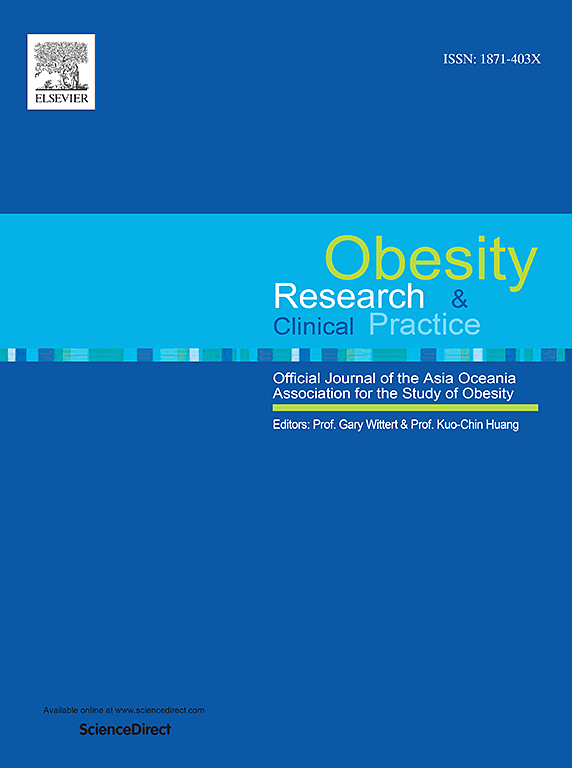Effects of intermittently scanned continuous glucose monitoring on body weight and glycemic variability in individuals with overweight and impaired glucose tolerance or mild diabetes: A pilot randomized controlled trial
IF 2.5
4区 医学
Q3 ENDOCRINOLOGY & METABOLISM
引用次数: 0
Abstract
Objective
To investigate the effect of visualizing blood glucose variability by intermittently scanned continuous glucose monitoring (isCGM) on weight reduction in overweight individuals with impaired glucose tolerance (IGT) or mild type 2 diabetes mellitus (T2DM).
Materials and methods
Forty overweight (BMI, ≥25 kg/m2) individuals with IGT or T2DM (drug naïve; HbA1c, ≤7.0 %) were included in this 24-week randomized controlled trial. Participants were randomly assigned to the control group (diet and exercise therapy) or the isCGM group (diet and exercise therapy plus isCGM). The primary endpoint was the change in body weight during the 24-week intervention period.
Results
One participant in the isCGM group withdrew consent. We therefore analyzed 19 individuals in the isCGM group and 20 in the control group. Baseline BMI was significantly higher in the isCGM group (35.2 ± 5.7 kg/m²) compared to the control group (31.6 ± 6.8 kg/m²). Weight change in the isCGM and control groups (–1.8 and –2.2 kg) did not differ. However, the change in coefficient of variation (–0.9 and 2.9 %) of sensor glucose differed significantly between the two groups. isCGM scan frequency was positively correlated with time above range (TAR) during the first month, positively correlated with the change in protein intake, and negatively correlated with that in TAR.
Conclusion
While isCGM use in overweight individuals with IGT or mild T2DM did not reduce body weight, it might have influence dietary behavior. The negative correlation between scan frequency and TAR, and the positive correlation between scan frequency and protein intake suggest that self-awareness of glucose fluctuations contributed to behavioral change.
间歇性扫描连续血糖监测对糖耐量受损或轻度糖尿病超重个体体重和血糖变异性的影响:一项先导随机对照试验
目的:探讨间歇扫描连续血糖监测(isCGM)显示血糖变异性对糖耐量受损(IGT)或轻度2型糖尿病(T2DM)超重患者体重减轻的影响。材料与方法:超重(BMI≥25 kg/m2) IGT或T2DM患者40例(药物naïve;HbA1c≤7.0 %)纳入这项为期24周的随机对照试验。参与者被随机分配到对照组(饮食和运动疗法)或isCGM组(饮食和运动疗法加isCGM)。主要终点是24周干预期间体重的变化。结果:isCGM组1名受试者撤回同意。因此,我们分析了isCGM组的19名患者和对照组的20名患者。isCGM组的基线BMI(35.2 ± 5.7 kg/m²)明显高于对照组(31.6 ± 6.8 kg/m²)。isCGM组和对照组的体重变化(-1.8和-2.2 kg)没有差异。然而,传感器葡萄糖的变异系数变化(-0.9和2.9 %)在两组之间差异显著。isCGM扫描频率与第一个月的时间高于范围(TAR)呈正相关,与蛋白质摄入量的变化呈正相关,与TAR呈负相关。结论:虽然超重的IGT或轻度T2DM患者使用isCGM并没有减轻体重,但它可能影响饮食行为。扫描频率与TAR呈负相关,扫描频率与蛋白质摄入量呈正相关,表明对葡萄糖波动的自我意识有助于行为改变。
本文章由计算机程序翻译,如有差异,请以英文原文为准。
求助全文
约1分钟内获得全文
求助全文
来源期刊

Obesity research & clinical practice
医学-内分泌学与代谢
CiteScore
7.10
自引率
0.00%
发文量
80
审稿时长
49 days
期刊介绍:
The aim of Obesity Research & Clinical Practice (ORCP) is to publish high quality clinical and basic research relating to the epidemiology, mechanism, complications and treatment of obesity and the complication of obesity. Studies relating to the Asia Oceania region are particularly welcome, given the increasing burden of obesity in Asia Pacific, compounded by specific regional population-based and genetic issues, and the devastating personal and economic consequences. The journal aims to expose health care practitioners, clinical researchers, basic scientists, epidemiologists, and public health officials in the region to all areas of obesity research and practice. In addition to original research the ORCP publishes reviews, patient reports, short communications, and letters to the editor (including comments on published papers). The proceedings and abstracts of the Annual Meeting of the Asia Oceania Association for the Study of Obesity is published as a supplement each year.
 求助内容:
求助内容: 应助结果提醒方式:
应助结果提醒方式:


